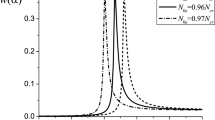Abstract
The results are presented from the theoretical analysis of the low-threshold parametric decay instability of the pumping microwave beam with the ordinary polarization and the frequency in the electron cyclotron resonance frequency range. This instability develops in the cylindrical plasma filament, which results in the excitation of two oblique Langmuir waves.


Similar content being viewed by others
REFERENCES
B. I. Cohen, R. H. Cohen, W. M. Nevins, and T. D. Rognlien, Rev. Mod. Phys. 63, 949 (1991).
E. Westerhof, S. K. Nielsen, J. W. Oosterbeek, M. Salewski, M. R. de Baar, W. A. Bongers, A. Bürger, B. A. Hennen, S. B. Korsholm, F. Leipold, D. Moseev, M. Stejner, D. J. Thoen, and the TEXTOR Team, Phys. Rev. Lett. 103, 125001 (2009).
S. K. Nielsen, M. Salewski, E. Westerhof, W. Bongers, S. B. Korsholm, F. Leipold, J. W. Oosterbeek, D. Moseev, M. Stejner, and the TEXTOR Team, Plasma Phys. Control. Fusion 55, 115003 (2013).
S. K. Hansen, S. K. Nielsen, J. Stober, J. Rasmussen, M. Salewski, M. Stejner, M. Hoelzl, and the ASDEX Upgrade Team, in Proceedings of the 46th EPS Conference on Plasma Physics, Milan,2019, ECA 43C, P1.1075.
S. Coda for the TCV Team, Nucl. Fusion 55, 104004 (2015).
M. Martínez, B. Zurro, A. Baciero, D. Jiménez-Rey, and V. Tribaldos, Plasma Phys. Control. Fusion 60, 025024 (2018).
E. Z. Gusakov and A. Yu. Popov, Phys. Plasmas 23, 082503 (2016).
A. Yu. Popov and E. Z. Gusakov, Europhys. Lett. 116, 45002 (2016).
A. B. Altukhov, V. I. Arkhipenko, A. D. Gurchenko, E. Z. Gusakov, A. Yu. Popov, L. V. Simonchik, and M. S. Usachonak, Europhys. Lett. 126, 15002 (2019).
E. Z. Gusakov, A. Yu. Popov, and P. V. Tretinnikov, JETP Lett. 108, 93 (2018).
S. Kubo, M. Nishiura, K. Tanaka, T. Shimozuma, Y. Yoshimura, H. Igami, H. Takahashi, T. Mutoh, N. Tamura, Y. Tatematsu, T. Saito, T. Notake, S. B. Korsholm, F. Meo, S. K. Nielsen, et al., Rev. Sci. Instrum. 81, 10D535 (2010).
A. Bruschi, E. Alessi, W. Bin, O. D’Arcangelo, B. Baiocchi, F. Belli, G. Calabrò, I. Casiraghi, V. Cocilovo, L. Figini, C. Galperti, S. Garavaglia, G. Granucci, G. Grosso, S. B. Korsholm, et al., Nucl. Fusion 57, 076004 (2017).
E. Z. Gusakov, A. Yu. Popov, A. N. Saveliev, and E. V. Sysoeva, Plasma Phys. Control. Fusion 59, 075002 (2017).
E. Z. Gusakov and A. Yu. Popov, Phys. Plasmas 25, 012101 (2018).
E. Z. Gusakov, A. Yu. Popov, and A. N. Saveliev, Plasma Phys. Control. Fusion 61, 025006 (2019).
E. Z. Gusakov and V. I. Fedorov, Sov. J. Plasma Phys. 5, 263 (1979).
L. Simonchik, A. Altukhov, V. Arkhipenko, A. Gurchenko, E. Gusakov, A. Popov, and M. Usachonak, in Proceedings of the 46th EPS Conference on Plasma Physics, Milan,2019, ECA 43C, P2.4012.
A. Sommerfeld, Partial Differential Equations in Physics (Academic Press, New York, 1949), Vol. 1.
A. Yu. Popov, P. V. Tretinnikov, E. Z. Gusakov, and L. V. Simonchik, Plasma Phys. Rep. 46, 430 (2020).
E. Z. Gusakov and V. I. Fedorov, Sov. J. Plasma Phys. 5, 463 (1979).
Handbook of Mathematical Functions with Formulas, Graphs, and Mathematical Tables, Ed. by M. Abramowitz and I. A. Stegun, 9th Ed. (Dover, New York, 1972), Ch. 22, p. 771.
Funding
The calculations of the instability threshold and growth rate were supported by the Russian Foundation for Basic Research and the Belarus Foundation for Basic Research (project no. 18-52-00010-F18R-040). The calculations of the nonlinear plasma susceptibility were supported by Ioffe Institute under the State Contract.
Author information
Authors and Affiliations
Corresponding author
Additional information
Translated by I. Grishina
APPENDIX
APPENDIX
Let us derive the expression for the nonlinear plasma susceptibility, which describes the nonlinear interaction of the OL waves in the presence of the ordinary wave. We use the Cartesian coordinate system and assume that the plasma is homogeneous. In this case, the electron density is the sum of the unperturbed component and the first and second order perturbations at frequencies of the daughter waves:
In the electric fields of the high-frequency oscillations, the corresponding electron velocities also have the linear and non-linear components:
The linear components of the electron oscillation velocities in the electric fields of three microwaves can be found by means of solving the moment equations written in the following form:
where \({{\Delta }_{{1,2}}} = \omega _{{1,2}}^{2} - \omega _{{ce}}^{2}\). Then, using the continuity equation, we obtain the expressions for the linear perturbations of the background density at frequencies of the interacting waves:
The second-order charge density at a frequency of the first OL wave is determined by the following expression:
where the second-order correction to the components of the electron oscillation velocity at a frequency of the first OL wave is the solution of the moment equations
where \({{H}_{x}} = {{k}_{y}}\frac{c}{{{{\omega }_{0}}}}{{E}_{z}}\) and \({{H}_{y}} = - {{k}_{x}}\frac{c}{{{{\omega }_{0}}}}{{E}_{z}}\). Substituting expressions (А.3), (A.4), and (A.6) into expression (A.5), we obtain the following expressions:
It can be demonstrated that the second-order charge density at a frequency of the second OL wave obeys the following equation:
Rights and permissions
About this article
Cite this article
Gusakov, E.Z., Popov, A.Y. & Simonchik, L.V. On the Issue of Possibility of Low-Threshold Nonlinear Excitation of Oblique Langmuir Waves in Plasma Filament Using Ordinary Polarized Microwaves. Plasma Phys. Rep. 46, 1067–1074 (2020). https://doi.org/10.1134/S1063780X20110033
Received:
Revised:
Accepted:
Published:
Issue Date:
DOI: https://doi.org/10.1134/S1063780X20110033



